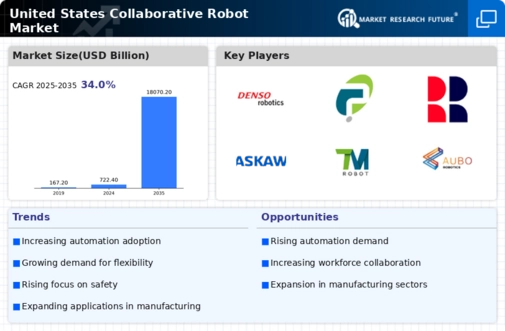Growing focus on human-robot collaboration is driving the market growth
The United States collaborative robot industry is expanding rapidly due to the growing emphasis on human-robot collaboration across industries. As businesses seek to increase efficiency, safety, and production, collaborative robots or cobots provide an attractive response. While typical industrial robots frequently require safety cages and function independently of humans, cobots are meant to work alongside human workers in a shared office. Sensor technology and artificial intelligence developments enable cobots to recognize and respond to human presence while ensuring safe interactions. With a market CAGR exceeding expectations, companies increasingly adopt collaborative robots to enhance productivity while ensuring safety.
Sensor technology advancements, artificial intelligence, and flexible programming drive market growth. Furthermore, cost-effectiveness and regulatory compliance drive collaborative robot adoption across various sectors, indicating their presence in modern workplaces. Companies also recognize collaborative robots are more cost-effective than traditional automation systems as they require less infrastructure and can be rapidly installed and modified to meet changing production demands.
Furthermore, the collaborative robot market is experiencing rapid growth due to the flexibility and adaptability of these robots across various industries. Unlike traditional industrial robots, collaborative robots are designed to work with humans without safety barriers, enabling seamless integration into diverse work environments. This adaptability is particularly desirable in manufacturing, automotive, electronics, healthcare, and logistics industries, where activities might change significantly and require constant restructuring. The United States market is also growing due to continued advances in collaborative robot technology, which include better sensors, higher AI capabilities, and easy programming interfaces that allow for rapid deployment and reconfiguration.
The emphasis on workplace safety and ergonomics further drives the adoption of collaborative robots, as they mitigate risks associated with repetitive tasks and heavy lifting, thereby reducing the likelihood of injuries and enhancing employee well-being. For instance, at CES 2024, Doosan Robotics Inc., a renowned collaborative robot (cobot) manufacturer, revolutionized the robotics industry by unveiling cutting-edge cobots and AI technologies, all under a cohesive theme. As industries seek to optimize processes and respond to dynamic market demands, the agility of cobots becomes increasingly invaluable, driving the collaborative robot market revenue.
















Leave a Comment